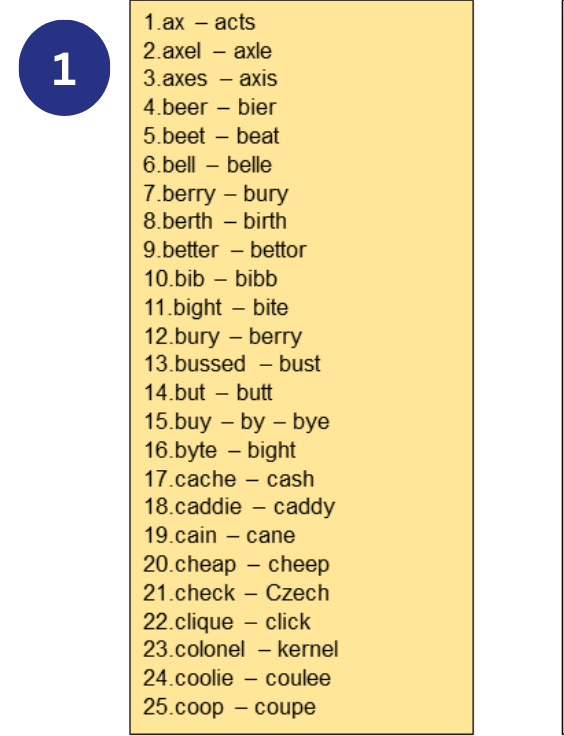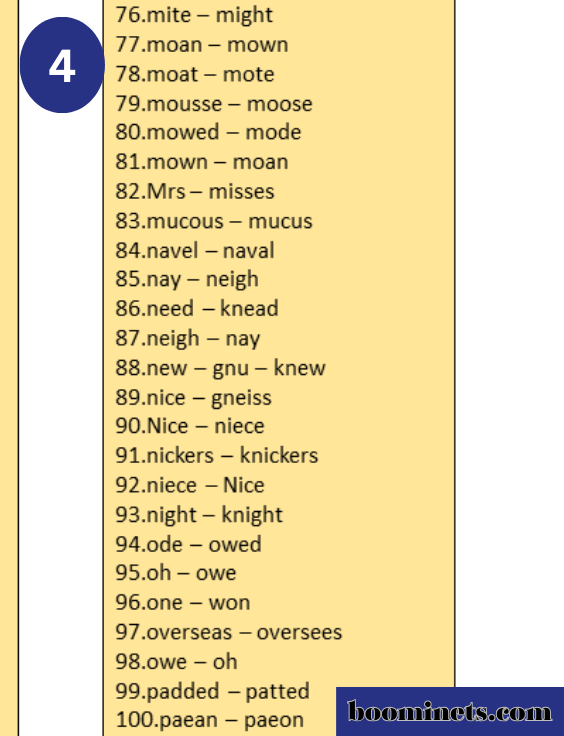100 Sentences of Future Perfect Continuous Tense: A Comprehensive Guide

- 1.ax – acts
- 2.axel – axle
3.axes – axis - 4.beer – bier
- 5.beet – beat
- 6.bell – belle
- 7.berry – bury
8.berth – birth - 9.better – bettor
- 10.bib – bibb
- 11.bight – bite
- 12.bury – berry
- 13.bussed – bust
- 14.but – butt
- 15.buy – by – bye
- 16.byte – bight
- 17.cache – cash
- 18.caddie – caddy
- 19.cain – cane
- 20.cheap – cheep
- 21.check – Czech
- 22.clique – click
- 23.colonel – kernel
- 24.coolie – coulee
- 25.coop – coupe

- 26.council – counsel
- 27.coup – coo
- 28.course – coarse
- 29.cousin – cozen
- 30.coward – cowered
- 31.coy – koi
- 32.cozen – cousin
- 33.craft – kraft
- 34.crape – crepe
- 35.crawl – kraal
- 36.creak – creek
- 37.crepe – crape
- 38.dyeing – dying
- 39.fare – fair
- 40.fate – fete
- 41.faun – fawn
- 42.fax – facts
- 43.faze – phase
- 44.feat – feet
- 45.feint – faint
- 46.fends – fens
- 47.flour – flower
- 48.flow – floe
- 49.flower – flour
- 50.flu – flue – flew

- 51.graft – graphed
- 52.graham – gram
- 53.graphed – graft
- 54.heroin – heroine
- 55.hertz – hurts
- 56.hew – hue
- 57.hey – hay
- 58.hi – high
- 59.higher – hire
- 60.him – hymn
- 61.hire – higher
- 62.ho – hoe
- 63.hoard – horde
- 64.hoarse – horse
- 65.hoe – ho
- 66.hoes – hose
- 67.hold – holed
- 68.hole – whole
- 69.holed – hold
- 70.hue – hew
- 71.humerus
- 72.leased – least
- 73.led – lead
- 74.lee – lea
- 75.leech – leach

- 76.mite – might
- 77.moan – mown
- 78.moat – mote
- 79.mousse – moose
- 80.mowed – mode
- 81.mown – moan
- 82.Mrs – misses
- 83.mucous – mucus
- 84.navel – naval
- 85.nay – neigh
- 86.need – knead
- 87.neigh – nay
- 88.new – gnu – knew
- 89.nice – gneiss
- 90.Nice – niece
- 91.nickers – knickers
- 92.niece – Nice
- 93.night – knight
- 94.ode – owed
- 95.oh – owe
- 96.one – won
- 97.overseas – oversees
- 98.owe – oh
- 99.padded – patted
- 100.paean – paeon
Homonyms are fascinating linguistic phenomena that add depth and complexity to the English language. These words, while spelled identically or similarly, possess distinct meanings, making them a unique aspect of English vocabulary. In this article, we delve into homonyms examples, exploring the nuances and versatility they offer.
Understanding Homonyms
Homonyms, derived from Greek roots meaning “same name,” are words that share the same spelling or pronunciation but have different meanings. This linguistic ambiguity contributes to the richness of language but can also pose challenges in comprehension, especially for non-native speakers.
Examples of Homonyms
Let’s explore some common examples of homonyms:
- Bear:
- Bear (noun): A large mammal.
- Bear (verb): To carry or support.
- Bat:
- Bat (noun): A flying mammal.
- Bat (verb): To hit or strike.
- Tear:
- Tear (noun): A drop of saline fluid from the eye.
- Tear (verb): To rip or shred.
- Wind:
- Wind (noun): Air in motion.
- Wind (verb): To twist or spiral.
- Bow:
- Bow (noun): A knot tied with two loops and two loose ends.
- Bow (verb): To bend the upper part of the body as a sign of respect.
- Bank:
- Bank (noun): Financial institution.
- Bank (verb): To tilt or incline to one side.
- Can:
- Can (noun): A cylindrical container.
- Can (verb): To be able to or have the capacity to.
- Saw:
- Saw (noun): Cutting tool with a toothed edge.
- Saw (verb): To cut using a saw.
- Right:
- Right (noun): Moral or legal entitlement.
- Right (adjective): Opposite of left.
- Bat:
- Bat (noun): Nocturnal flying mammal.
- Bat (verb): To hit or strike something.
- Bark:
- Bark (noun): The outer covering of a tree.
- Bark (verb): The sound made by a dog.
- Light:
- Light (noun): Illumination.
- Light (adjective): Not heavy.
- Fair:
- Fair (noun): Exhibition or event.
- Fair (adjective): Just or impartial.
- Date:
- Date (noun): Calendar day.
- Date (verb): To go out socially with someone.
- Book:
- Book (noun): Bound collection of pages.
- Book (verb): To reserve or arrange for something in advance.
Exploring the Diversity of Homonyms
Homonyms contribute to the versatility of the English language, enabling writers and speakers to convey intricate meanings with precision. Whether intentionally employed for wordplay or encountered serendipitously, homonyms enrich communication by offering multiple interpretations within a single lexical framework.
The Importance of Context
Context plays a crucial role in disambiguating homonyms. The surrounding words, phrases, or sentences provide clues that aid in determining the intended meaning of a homonymous word. Therefore, mastering contextual comprehension is essential for effectively navigating the intricacies of homonyms in everyday communication.
Enhancing Vocabulary and Language Skills
Studying homonyms is beneficial for individuals looking to enhance their vocabulary and language skills. By familiarizing themselves with various homonyms and their contextual usage, learners can improve their linguistic proficiency and develop a nuanced understanding of English semantics.
Conclusion
Homonyms exemplify the complexity and richness of the English language, offering an array of meanings within a single lexical form. Through exploration and contextual understanding, individuals can appreciate the intricacies of homonyms and leverage them effectively in written and spoken communication. Embracing the diversity of homonyms contributes to linguistic fluency and fosters a deeper appreciation for the boundless possibilities of language.
In conclusion, homonyms exemplify the intricacies of English vocabulary, enriching communication with their diverse meanings and contextual nuances. Embracing and understanding homonyms enhance linguistic proficiency and foster a deeper appreciation for the richness of the English language.



